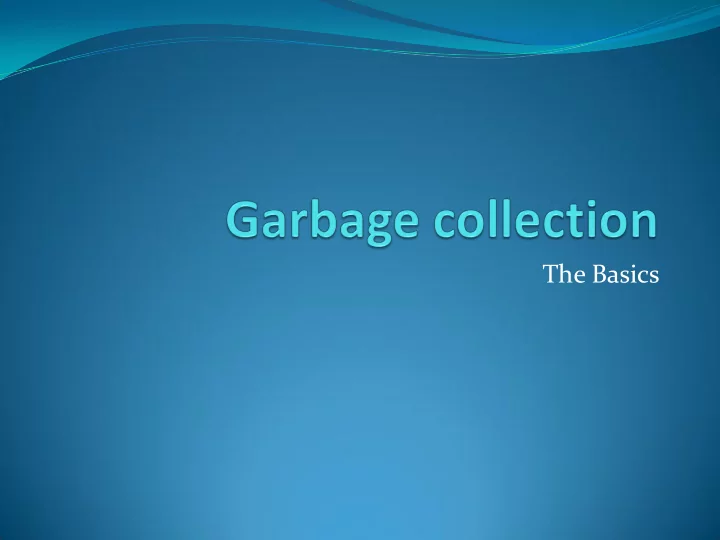

The Basics
What is memory management? Programs contain Objects Data Occupy memory Runtime system must allocate and reclaim memory for program in an efficient manner Why is this important? Why is this hard? Why is this interesting? 2
Allocation and Reclamation Allocation Objects dynamically allocated on HEAP malloc(), new() Reclamation Manual/Explicit free() delete() Automated Garbage collection (GC) 3
Explicit memory management challenges Consumes software development time new allocate storage for new object delete reclaim storage Dangling pointers (reclaim too soon) Foo* p = new Foo(); Foo* q = p; delete p; p->DoSomething(); p = NULL; q->ProcessFoo(); Statically undecidable Problem for developers 4
Explicit memory management challenges Memory leak (never reclaim) #include <stdlib.h> void f(void){ void* s; s = malloc(50); return; } int main(void){ while (1) f(); return 0; } 5
Explicit memory management pluses Efficiency can be very high Puts the programmer in control 6
Automated memory management Runtime system automatically Detects dead objects (garbage detection) Reclaims dead objects (garbage reclamation) Garbage collection Preserves software development time Relieves programmer burden Less prone to errors Utilized by most modern OOP and scripting languages Python, Java, C#, php 7
Garbage collection challenges public void f(){ Occurs an unpredictable startLaser(); times Obj o = new Obj(); stopLaser(); Duration is unbounded } Performance efficiency public static void main(…){ issues while (true) f(); } Time GC, Bad for Real- Time 8
Runtime system performs GC E.g. Java virtual machine (JVM) Software execution engine that executes your Java programs Java interpreter that converts byte code into OS specific commands Handles related tasks Memory management (GC implemented in JVM) Security Multithreading 9
Major concerns Explicit memory management Reclaiming objects at the right time Garbage collection Discriminating live objects from garbage Both Fast allocation Fast reclamation Low fragmentation 10
Layout of a program in memory High address Command line args and environment variables stack heap Uninitialized data Initialized to 0 by exec (bss) Initialized data Read from program file by exec Text / code Low address 11
Determining object liveness Live objects are needed in the computation Now or in the future Prove that an object is not live (dead) and reclaim its storage Reclaim dead objects soon, after it is last used How do we estimate liveness in practice? Approximate liveness by reachability from outside the heap Unreachable objects are garbage (reclaim storage) Reachable objects are live and must not be reclaimed 12
Identifying garbage reference counting stack heap (reachability) An integer is associated with every object, summing 2 0 Stack references 1 1 Heap references 1 1 Objects with reference 0 0 count of zero are dead 0 2 13
Problems with reference counting • Standard problem is that stack heap objects in cycles (and those touched by such objects) cannot be collected (reclaimed) 1 0 1 1 • Overhead of counting 1 1 can be high 0 0 0 2 14
Identifying garbage Tracing (reachability) Trace reachability from root set Processor registers Program stack Global variables Objects traced are reachable All other objects are unreachable (garbage) 15
The marking phase To find the dead objects, use the process of calculatus eliminatus Find all live objects All others are dead 16
The marking phase • To discover the dead stack heap objects, we – Find live objects • Pointers from the stack to the heap make objects live 17
The marking phase • To discover the dead stack heap objects, we – Find live objects • Pointers from the stack to the heap make objects live • These objects make other objects live 18
The sweep phase • To discover the dead stack heap objects, we – Find live objects – Sweep all others away as dead 19
Mark and sweep: Tracing example • To discover the dead stack heap objects, we – Find live objects – Sweep all others away as dead – Perhaps compact the heap – Problem: – Mark phase can take unbounded time 20
Recommend
More recommend